Today, there is no doubt that great efforts are being made in terms of the conservation of endangered species. But this has not been conducted equally: in recent years, several experts have warned that our conservation efforts tend to focus on species that are close, likeable or endearing to us —such as pandas, whales, elephants and polar bears. However, nature does not care about aesthetics, it only cares about the need to preserve all species for their ecological value. Here we point out some of the most bizarre and amazing animals on our planet. Some of them may not actually inspire us emotionally or please us aesthetically, but they also deserve to survive.
Yoda bat (Nyctimene sp.)
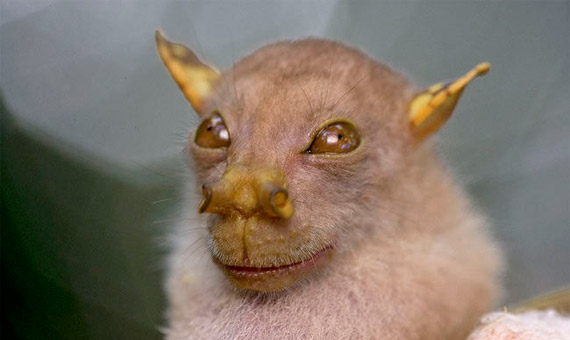
Winged mammals seem especially prone to surprising us with their peculiar appearance. One of the strangest is one which until now has simply been known as the Yoda bat, due to the fact that some people think it resembles the character from the Star Wars film saga. The animal, which lives in the jungles of Papua New Guinea, had been observed previously, but it was during an expedition sponsored by Conservation International in 2009 when it became popular on the Internet. At this point, scientists only know that it probably belongs to the Nyctimene genus, a type of fruit bat spread throughout Oceania that plays an important ecological role in seed dispersal. Incidentally, one thing that can be added regarding this curious bat is that some people categorically deny its resemblance to Yoda.
Heike crab (Heikeopsis japonica)
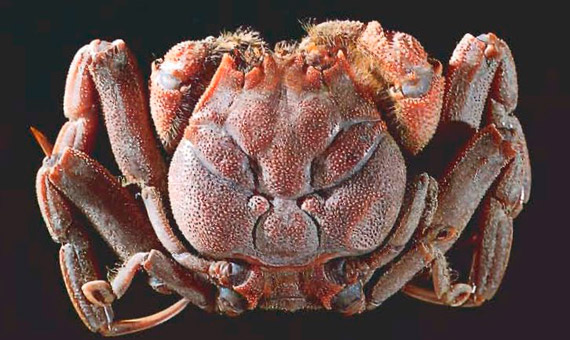
When contemplating the appearance of the Heike crab or Heikegani, and bearing in mind that it inhabits the seas of Japan, one realises that it is not surprising that local mythology was used to liken this crustacean to the face of a samurai. Popular tradition sees them as reincarnations of the Heike, a clan that was defeated in a battle for the imperial throne in 1185. In his Cosmos series, astronomer Carl Sagan suggested that the features of the crab were an example of artificial selection, since fishermen used to free the caught specimens that most resembled human faces, assuming that they harboured the spirits of the dead warriors. However, other experts have questioned this explanation, arguing that the Heike crab is not used as food. As for their strange markings, they work as anchors for the insertion of their muscles.
Blobfish (Psychrolutes marcidus)

In its natural habitat, the blobfish does not have a particularly striking appearance, but things change when it leaves the water. Being a deep-water species –found at a depth of between 600 and 1,200 metres– this inhabitant of the coasts of Australia and New Zealand has developed a peculiar way of maintaining its buoyancy, without the assistance of gas swim
bladders, which in fact would not work very well at such depths. Instead, this approximately 30 centimetre-long fish has a rather gelatinous body, thus giving it a lower density than water. Yet, when it is taken out of the water, its flesh spreads, resulting in a shocking appearance that has become very popular on the Internet. In 2013, its apparently sad and melancholic face, which has even been recreated in stuffed animals, earned it a prize from the Ugly Animal Preservation Society. Experts warn that it could be at risk of extinction because it is often accidentally caught by deep water fishing nets.
Aye-aye (Daubentonia madagascariensis)
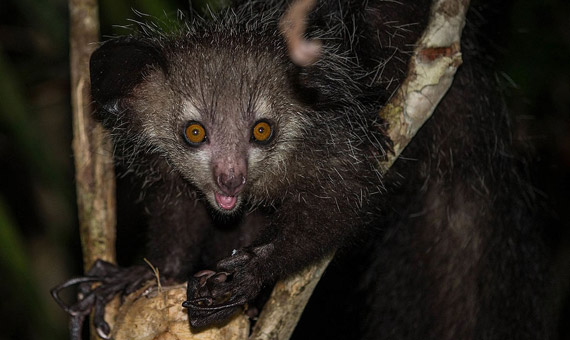
The island of Madagascar is a natural experiment in independent evolution. Having separated from other land masses around 88 million years ago, it is home to many unique species, lineages which are not found anywhere else in the world. Undoubtedly, the most renowned and representative Madagascan animals are the lemurs. And this term, which in Roman mythology referred to evil spirits, perhaps began to be applied to these endemic primates of Madagascar because of the aye-aye. This is a rare lemur, unique in its family. Its unattractive appearance to the human eye has made it a victim of superstition: the locals exterminate it as they consider it to be a messenger of misfortune which can even cause death with its thin and bony middle finger —as the british naturalist Gerald Durrell masterfully narrated in the book “The Aye-Aye and I”, following an expedition in 1990. In fact, the aye-aye’s middle finger is a unique adaptation among mammals; it is used to tap trees in search of hollows where the larvae it feeds on are hidden.
Goblin shark (Mitsukurina owstoni)
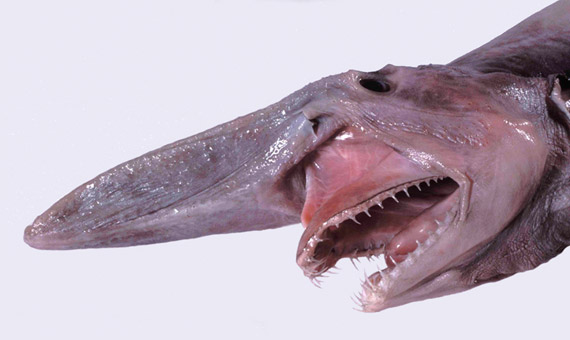
Many of these strange sea creatures have unique adaptations that give them an unusual appearance. This is the case of the goblin shark. Although known since 1898, its initial classification was unclear due to its most prominent anatomical feature: a flattened snout under which a hidden mouth projects forward, exhibiting fearsome teeth. With its mouth fully deployed, it would seem that a crocodile is coming out of its mouth. It was this peculiarity that hindered its identification, since specimens with hidden and projected mouths looked like different species. Finally, it was determined that the goblin shark is the only heir of a family that went extinct 125 million years ago. It is spread along the coasts of every ocean, although it does not usually interact with human beings because it prefers depths of under 100 meters.
Hagfish (Myxini)
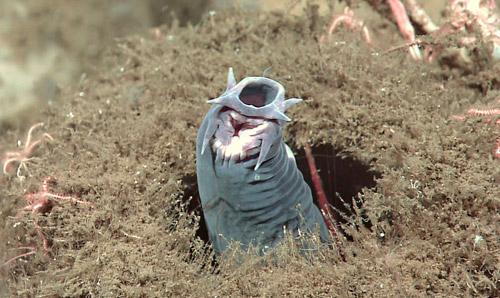
In regard to strange inhabitants of the deep sea, hagfish are not only uncommon due to their threatening sea snake appearance –sometimes measuring over one metre in length–, or for their habit of secreting large amounts of a kind of mucus that can clog the gills of their attackers, or for their unpleasant way of devouring their larger prey from within, introducing themselves in the viscera of their victims, thanks to the fact that their mouths have no jaws and possess serrated plates, but also for the fact that the aberrant body structure of these primitive animals –which possess a skull but no vertebrae– has meant that they have been kept in a sort of taxonomic limbo while zoologists debated where to position them. Today, they are considered relatives of lampreys, although it is thought that hagfish represent degenerate forms that have lost many characteristics typical of their relatives.
Panda ant (Mutillidae)
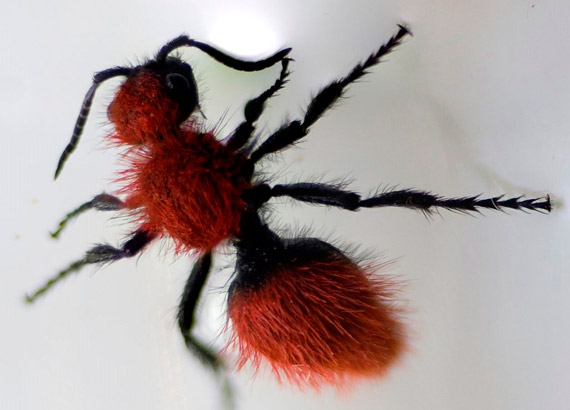
When is an ant not an ant? When in fact they are wingless wasps, capable of inflicting stings that are so painful that in some places they are known as “cow killers”. The mutillidae family comprises some 8,000 species that are spread all over the world, especially in the dry tropics. The females –the only ones that sting and which are wingless– are known as velvet ants for their abundant brightly-coloured hair, which acts as a warning sign to deter potential predators from the danger they incur if they dare disturb them. Some are austerely coloured black and white, which has earned them the nickname panda ants, which is doubly misleading. Adults feed on plant juices, but their larvae grow up eating the offspring of other wasps or bees.
Kermit frog (Hyalinobatrachium dianae)

So-called glass frogs –which live in the tropical Americas– have been known for decades for the translucent skin of their abdomen, which shows their internal organs. However, since 1973, no new species of this group had been discovered, until 2015, when an expedition in the jungles of Costa Rica found a new representative. The tiny frog, –measuring 2.5 centimetres in length–, not only reveals its bowels, but its green skin and bulging white eyes with black pupils led internet users to compare it to The Muppets’ own Kermit the Frog due to its striking resemblance. And exploiting the advertising potential, Disney published an interview in which the famous muppet commented on his new relative. Despite many people’s wishes, the frog does not bear this curious fact in its official name; the main discoverer, who did not notice the resemblance, named it in honour of his mother, Diane.
Comments on this publication